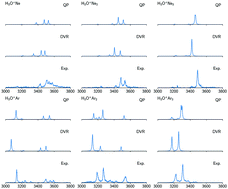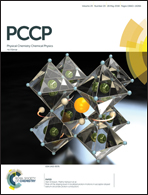Fermi resonance in solvated H3O+: a counter-intuitive trend confirmed via a joint experimental and theoretical investigation†
Abstract
The spectral features of H3O+ between 3000 and 3800 cm−1 are known to be dominated by coupling between the fundamentals of stretching modes and the overtones of bending modes. A strong Fermi resonance (FR) pattern has been observed in Ar-tagged H3O+, and the sensitive dependence of the FR pattern on the number of Ar tags has been analyzed by Li et al. [J. Phys. Chem. A, 2015, 119(44), 10887]. Based on ab initio anharmonic calculations with MP2/aug-cc-pvDZ, Tan et al. investigated the influence of different types of rare gas and found a counter-intuitive trend that the strength of the coupling between the overtones of bending modes and the fundamentals of stretching modes decreases as the strength of solvation increases [Phys. Chem. Chem. Phys., 2016, 18(44), 30721]. In the present work, we combine both experimental and theoretical tools to gain a better understanding of the FR in H3O+. Experimentally, spectra of H3O+ with light and much more weakly-bound Ne tags were measured for the first time and spectra of Ar-tagged H3O+ were re-measured for comparison. Theoretically, we have implemented several computational schemes to improve both the accuracy and efficiency of the anharmonic treatments with higher-level ab initio methods (up to CCSD/aug-cc-pVTZ). With the good agreement between the experimental and theoretical spectra, we are confident about the prediction of the modulation of coupling strength by the solvation environments.

- This article is part of the themed collection: 2018 PCCP HOT Articles


 Please wait while we load your content...
Please wait while we load your content...